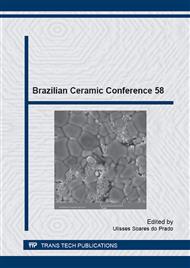[1]
L. Zhang: Construc Build Mater Vol. 47 (2013), p.643.
Google Scholar
[2]
S.N. Monteiro, C.M.F. Vieira: Construc. Build Mater. Vol. 68 (2014), p.599.
Google Scholar
[3]
S.N. Monteiro, C.M.F. Vieira: Ceramics Intern. Vol. 30 (2004), p.381.
Google Scholar
[4]
S.N. Monteiro, C.M.F. Vieira: Applied Clay Science Vol. 27 (2004), p.229.
Google Scholar
[5]
C.M.F. Vieira, S.N. Monteiro: Materials Science Forum Vols. 727-728 (2012), p.965.
Google Scholar
[6]
L.N.L. Sanana, B.J. da Silva, W.P. Gonçalves, J.M. CArtaxo, B.S. Lira, R.C. dos Santos, R.R. Menezes: Materials Science Forum Vols. 727-728 (2012), p.721.
DOI: 10.4028/www.scientific.net/msf.727-728.721
Google Scholar
[7]
F.A. Silva, I.D.S. Pereira, S.L. Dias, G.A. Neves, H.L. Lira: Materials Science Forum Vols. 727-728 (2012), p.775.
Google Scholar
[8]
F. Monteiro, T. Machado, J. Sousa, E. Harim, S. Valcacer, R. Nascimento: Materials Science Forum Vols. 727-728 (2012), p.837.
DOI: 10.4028/www.scientific.net/msf.727-728.837
Google Scholar
[9]
S.C. Maestrelli, C.D. Roveri, N.A. Mariano, L.M. Faustino, G.F. Aielo, L.P.A. Pinto, C. Manochio, A.G.P. Nunes, T.M.L. Cal, F.F. Ribeiro: Materials Science Forum Vols. 727-728 (2012), p.1490.
DOI: 10.4028/www.scientific.net/msf.727-728.1490
Google Scholar
[10]
Brazilian Association of Technical Norms. Soil - Granulometric Analysis. Rio de Janeiro: ABNT 1988. (NBR7181). (In Portuguese).
Google Scholar
[11]
Brazilian Association of Technical Norms. Soil – Determination of the Specific Mass of Particles. Rio de Janeiro: ABNT 1984. (NBR6508). (In Portuguese).
Google Scholar
[12]
Brazilian Association of Technical Norms. Soil – Determination of the Plasticity Limit. Rio de Janeiro: ABNT 1988. (NBR7180). (In Portuguese).
Google Scholar
[13]
Brazilian Association of Technical Norms. Determination of the Fluidity Limit Rio de Janeiro: ABNT 1984. (NBR6459). (In Portuguese).
Google Scholar
[14]
American Society for Testing and Materials - ASTM C 373-372, Water absorption, bulk density, apparent porosity and apparent specific gravity of fired whiteware products, USA, (1972).
DOI: 10.1520/c0373-88r06
Google Scholar
[15]
American Society for Testing and Materials – ASTM C 674-677, Flexural properties of ceramic whiteware materials, USA, (1977).
Google Scholar
[16]
P.S. Santos: Science and Technology of Clays. (Edgard Blucher 2nd ed. Vol. 1, São Paulo, 1989). (In Portuguese).
Google Scholar
[17]
Brazilian Association for Technical Norms. Ceramic components Part 1: Hollow ceramic blocks for non load-bearing masonry - Terminology and requirements. Rio de Janeiro: ABNT 2005. (NBR 15270-1). (In Portuguese).
Google Scholar
[18]
. Brazilian Association of Technical Norms. Solid Ceramic for masonry – Evaluation of the compression strength. Rio de Janeiro: ABNT 1983. (NBR6460). (In Portuguese).
Google Scholar


